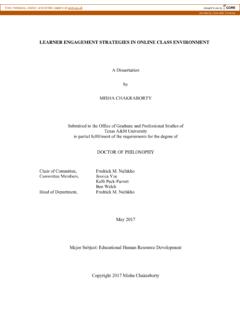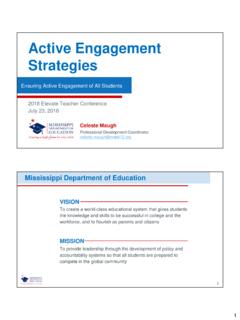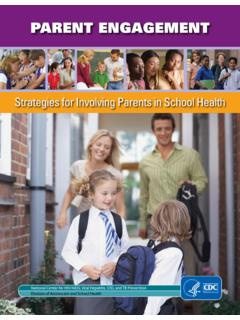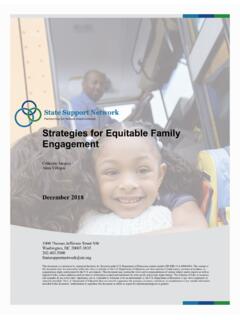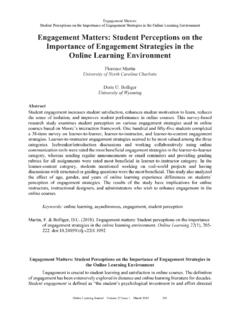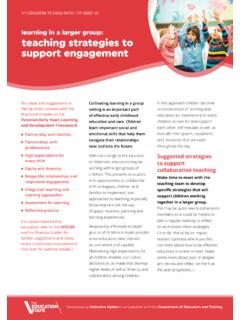Transcription of Family Engagement: A Guide to Tools, Strategies and …
1 A TASC RESOURCE GUIDEF amily engagement : A Guide to Tools, Strategies and ResourcesSTRATEGIES TO BOOST Family ENGAGEMENTS chools and community partners know the importance of engaging families in children s academic, social and emotional development at school. But meaningfully linking families to school life is complex and difficult to achieve effectively. In ExpandED Schools, parents join with teachers, principals and community-partner leaders to add time to the school day to improve student outcomes, meet students needs and preferences, and incorporate parents visions into the school. But involving parents in planning is only one facet of Family engagement , and additional Strategies are required for higher levels of student success.
2 TASC created this toolkit to help school planning teams refine their Family engagement Strategies and clarify what they are trying to do, why, and how. We include a definition of Family engagement , specific Strategies and tactics that are rooted in the research on what works, and a curated collection of resources. We have also created a review of research literature as a companion Strategies listed below can help ensure that all members of the school and community partner staff honor and recognize families knowledge. These approaches help ensure that families are able to support their children s education, encourage growth, advocate for change, and collaborate with schools.
3 As a result, schools, community organizations and families together can boost student achievement, build a positive school culture, and provide young people with a stronger sense of community in and out of school. 2A TASC RESOURCE GUIDEHOW TO IMPLEMENT EFFECTIVE HOME/SCHOOL PARTNERSHIPS Effective Family engagement : Is grounded in partnership and shared responsibility among families, community organizations and schools Continues from birth through adolescence Occurs across multiple settings and contexts in which children can learnSchools and their community partners need to implement Strategies that are systematic, integrated, sustained and meaningful. Activities to engage parents and families should be linked to learning, and be collaborative and interactive.
4 The approaches detailed below are rooted in research on what Parental Self-Efficacy Establish opportunities for parents to build their own skills and deepen knowledge. Provide trainings and workshops that model for parents and guardians how to support reading and math skills for younger children and educate families on the middle school and high school selection process. For older students, provide workshops on the college application and financial aid processes. Provide multiple opportunities for families to be involved through a variety of activities at school and at home, and communicate with them regarding the various factors that promote students' academic success. Organize visitation opportunities so families can observe and participate in extended day activities and field trips to promote a culture of high expectations.
5 Use a monthly newsletter that informs parents about current curricular activities and book club reading material, and that showcases best work. Communicate with families regarding the factors that promote students' academic success. Help families access data, electronically and through other formats, about their child's attendance and performance. Also include guidelines for encouraging character skills, instilling parental expectations, and supporting student learning and growth regardless of the parent s skill level and educational background. Create opportunities for parents to connect and build networks. Some parents may feel more comfortable engaging with other families rather than school. Provide opportunities for parents to build relationships with each other to facilitate peer learning and information sharing via parent meetings or program events and TASC RESOURCE GUIDEE nsure Parents Know that Schools Want Their Involvement Create a welcoming school environment that respects and celebrates language and cultural diversity.
6 Display student work throughout the building and ensure families receive written communication in the home languages they speak, or provide translation services. Actively encourage and facilitate Family participation in school events. Publicize events early and often using multiple methods including on the school website or social media, via fliers or phone calls, and in newsletters. Make an effort to accommodate parents' work schedules. Facilitate relationship building and information sharing between families and school staff. Ensure that parent-teacher conferences are productive and include goal sharing, and maintain regular communication of student progress between formal meetings. Student-led conferences can be a powerful tool for increasing student accountability.
7 Teacher home visits, if possible, can also be an effective tool for establishing and maintaining relationships with families that promote school engagement . Provide opportunities for Family contributions and leadership. Regularly solicit parent feedback and input on school activities and events. Encourage parents with leadership capacity to be parent representatives on school leadership High Parental Aspirations Develop a culture of high expectations. Provide parents with information on academically enriching summer programs, offer information on local colleges and universities and encourage parents to attend campus visits. Provide workshops on financing college and applying for financial aid. Help ensure that parents don't make the assumption that finances will prevent their child from pursuing higher education.
8 Celebrate Success Exhibit work. Display student work throughout the hallways, designate a "Student of the Month," and hold quarterly assemblies to celebrate student achievement. Celebrate students. Build a strong school culture through quarterly celebrations, student-led performance assemblies, and parent nights showcasing student TASC RESOURCE Guide Share stories. Share stories that exemplify optimism and perseverance. Conversations should be focused on how to support all students with high levels of RESOURCESNow with Strategies in mind, we offer a review of resources including briefs, research papers and tip sheets to further inform implementation of strong Family engagement tactics. Community and Family engagement : Principals Share What Works (2006) A publication of the National Association for Elementary School Principals, National Association for Secondary School Principals and the Coalition for Community Schools, this paper explores ways in which principals of community schools and other principals who, though they may not yet identify their schools as community schools, are responding in a very similar manner work successfully with community partners, families and other key stakeholders to improve student outcomes.
9 Family Involvement in Elementary School Education (2006) This brief by the Harvard Family Research Project summarizes the evidence base that links Family involvement during the elementary school years to outcomes and programs that have been evaluated to show what works. Helping Families Pave the Path to College (2012) Harvard Family Research Project outlines five Strategies educators can use to help families pave the path to college by supporting developmental readiness, including open communication with families, college exploration activities like campus visits, peer networks, and student-led planning conferences. Family Involvement in Middle and High School Students Education (2007) This brief by the Harvard Family Research Project summarizes evidence that examines effective involvement during the middle and high school years.
10 Programs and initiatives should be mindful of approaching Family involvement in multiple ways, facilitating parents ability to monitor adolescents growth and progress, supporting youth and parents in the college transition, developing a climate of high expectations and being sensitive to cultural TASC RESOURCE Guide One Dream, Two Realities: Perspectives of Parents on America s High Schools (2008) This report by Civic Enterprises for the Bill and Melinda Gates Foundation discusses how regardless of income, education, and performance at the school, parents believe that their involvement is central to their child s academic success. Researchers asked a nationally representative sample of high school students parents to offer their suggestions on how to better involve them in their teenagers education.
